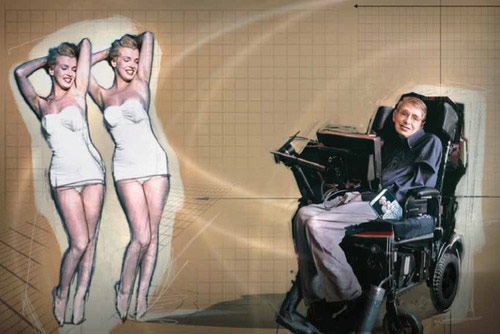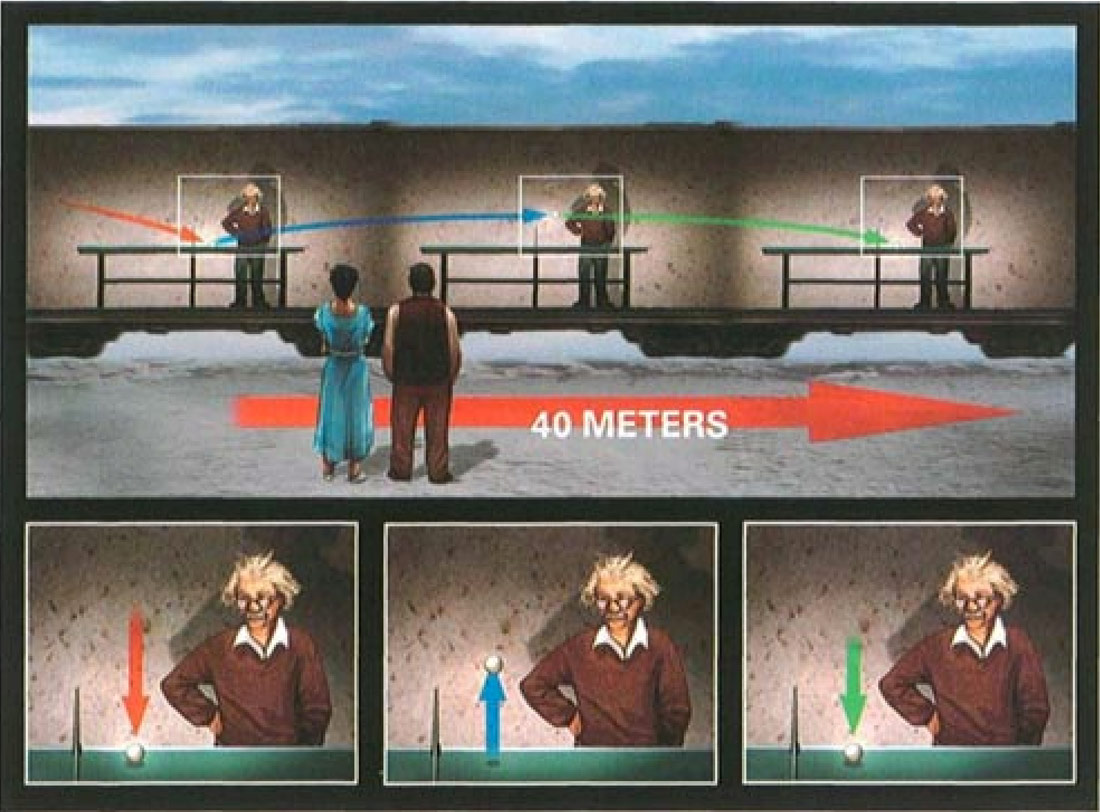Newtons Universe
Our present ideas about the motion of bodies date back to Galileo and Newton. Before them, people believed Aristotle, who said that the natural state of a body was to be at rest, and that it moved only if driven by a force or impulse. It followed that a heavier body should fall faster than a light one because it would have a greater pull toward the earth. The Aristotelian tradition also held that one could work out all the laws that govern the universe by pure thought: it was not necessary to check by observation. So no one until Galileo bothered to see whether bodies of different weights did in fact fall at different speeds. It is said that Galileo demonstrated that Aristotle’s belief was false by dropping weights from the Leaning Tower of Pisa in Italy. This story is almost certainly untrue, but Galileo did do something equivalent: he rolled balls of different weights down a smooth slope. The situation is similar to that of heavy bodies falling vertically, but it is easier to observe because the speeds are smaller. Galileo’s measurements indicated that each body increased its speed at the same rate, no matter what its weight. For example, if you let go of a ball on a slope that drops by one meter for every ten meters you go along, the ball will be traveling down the slope at a speed of about one meter per second after one second, two meters per second after two seconds, and so on, however heavy the ball. Of course a lead weight would fall faster than a feather, but that is only because a feather is slowed down by air resistance. If you drop two bodies that don’t have much air resistance, such as two different lead weights, they fall at the same rate. (We will see why shortly.) On the moon, where there is no air to slow things down, the astronaut David R. Scott performed the feather-and lead-weight experiment and found that indeed they did hit the ground at the same time.
Galileo’s measurements were used bv Newton as the basis of his laws of motion. In Galileo’s experiments, as a body rolled down the slope it was always acted on by the same force (its weight), and the effect was to make it constantly speed up. This showed that the real effect of a force is always to change the speed of a body, rather than just to set it moving, as was previously thought. It also meant that whenever a body is not acted on by any force, it will keep on moving in a straight line at the same speed. This idea was first stated explicitly in 1687, in Newton’s Principia Mathematica, and is known as Newton’s first law. What happens to a body when a force does act on it is given by Newton’s second law. This states that the body will accelerate, or change its speed, at a rate that is proportional to the force. (For example, the acceleration is twice as great if the force is twice as great.) The acceleration is also smaller the greater the mass (or quantity of matter) of the body. (The same force acting on a body of twice the mass will produce half the acceleration.) A familiar example is provided by a car: the more powerful the engine, the greater the acceleration, but the heavier the car, the smaller the acceleration for the same engine.
In addition to his laws of motion, which describe how bodies react to forces, Newton’s theory of gravity describes how to determine the strength of one particular type of force, gravity. As we have said, that theory states that every body attracts every other body with a force that is proportional to the mass of each body. Thus, the force between two bodies would be twice as strong if one of the bodies (say, body A) had its mass doubled. This is what you might expect, because one could think of the new body A as being made of two bodies, each with the original mass. Each of these would attract body B with the original force. Thus the total force between A and B would be twice the original force. And if, say, one of the bodies had six times the mass, or one had twice the mass and the other had three times the mass, then the force between them would be six times as strong.
You can now see why all bodies fall at the same rate. According to Newton’s law of gravity, a body of twice the weight will have twice the force of gravity pulling it down. But it will also have twice the mass and thus, according to Newton’s second law, half the acceleration per unit force. According to Newton’s laws, these two effects exactly cancel each other out, so the acceleration will be the same no matter what the weight.

Newton’s law of gravity also tells us that the farther apart the bodies, the lesser the force. The law says that the gravitational attraction of a star is exactly one-quarter that of a similar star at half the distance. This law predicts the orbits of the earth, the moon, and the planets with great accuracy. If the law were that the gravitational attraction of a star went down faster or slower with distance, the orbits of the planets would not be elliptical; they would either spiral into the sun or escape from the sun.
The big difference between the ideas of Aristode and those of Galileo and Newton is that Aristotle believed in a preferred state of rest, which any body would take up if it was not driven by some force or impulse. In particular, he thought that the earth was at rest. But it follows from Newton’s laws that there is no unique standard of rest. One could equally well say that body A was at rest and body B was moving at constant speed with respect to body A, or that body B was at rest and body A was moving. For example, if you set aside for a moment the rotation of the earth and its orbit around the sun, you could say that the earth was at rest and that a train on it was traveling north at ninety miles per hour or that the train was at rest and the earth was moving south at ninety miles per hour. If you carried out experiments with moving bodies on the train, all Newton’s laws would still hold. Is Newton right or is Aristotle, and how do you tell?
One test would be this: imagine you are enclosed in a box, and you do not know whether the box is resting on the floor of a moving train or on solid earth, the latter being the standard of rest according to Aristotle. Is there a way to determine which it is? If so, maybe Aristotle was correct—being at rest on the earth is special. But if you carried out experiments in your box on the train, they would turn out exactly the same as they would within your box on the "stationary" train platform (assuming no bumps, turns, or other imperfections in the train ride). Playing Ping-Pong on the train, you would find that the ball behaved just like a ball on a Ping-Pong table by the track. And if you are in your box and play the game at different speeds relative to the earth, say at zero, fifty, and ninety miles per hour, the ball will behave the same in all these situations. This is how the world behaves, and it is what the mathematics of Newton’s laws reflects: there is no way to tell whether it is the train or the earth that is moving. The concept of motion makes sense only as it relates to other objects.
Does it really matter whether Aristotle or Newton is correct? Is this merely a difference in outlook or philosophy, or is it an issue important to science? Actually, the lack of an absolute standard of rest has deep implications for physics: it means that we cannot determine whether two events that took place at different times occurred in the same position in space.
To picture this, suppose someone on a train bounces a Ping-Pong ball straight up and down, hitting the table twice on the same spot one second apart. To that person, the locations of the first and second bounces will have a spatial separation of zero. To someone standing beside the track, the two bounces would seem to take place about forty meters apart, because the train would have traveled that distance down the track between the bounces. According to Newton, the two observers have an equal right to consider themselves at rest, so both views are equally acceptable. One is not favored over another, as Aristotle had believed. The observed positions of events and the distances between them would be different for a person on the train and one beside the track, and there would be no reason to prefer one person’s observations to the other’s.
Newton was very worried by this lack of absolute position, or absolute space, as it was called, because it did not accord with his idea of an absolute God. In fact, he refused to accept the lack of absolute space, even though his laws implied it. He was severely criticized for this irrational belief by many people, most notably by Bishop Berkeley, a philosopher who believed that all material objects and space and time are an illusion. When the famous Dr. Johnson was told of Berkeley’s opinion, he cried, "I refute it thus!" and stubbed his toe on a large stone.

Both Aristotle and Newton believed in absolute time. That is, they believed that one could unambiguously measure the interval of time between two events and that this time would be the same whoever measured it, provided the person used a good clock. Unlike absolute space, absolute time was consistent with Newton’s laws. And it is what most people would take to be the commonsense view. However, in the twentieth century physicists realized that they had to change their ideas about both time and space. As we will see, they discovered that the length of time between events, like the distance between the points where the Ping-Pong ball bounced, depends on the observer. They also discovered that time was not completely separate from and independent of space. The key to these realizations was new insight into the properties of light. They may seem counter to our experience, but although our apparently commonsense notions work well when dealing with things such as apples, or planets that travel comparatively slowly, they don’t work at all for things moving at or near the speed of light.
Contents
-
Chapter 1
Thinking about the universe
-
Chapter 2
Our evolving picture of the universe
-
Chapter 3
The nature of a scientific theory
-
Chapter 4
Newton's Universe
-
Chapter 5
Relativity
-
Chapter 6
Curved Space
-
Chapter 7
The expanding Universe
-
Chapter 8
The big bang, black holes, and the evolution of the universe
-
Chapter 9
Quantum Gravity
-
Chapter 10
Wormholes and time travel
-
Chapter 11
The forces of nature and the unification of physics
-
Chapter 12
Conclusion